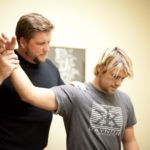It is virtually impossible to adjust yourself since a chiropractic adjustment is a specific force applied in a specific direction to a specific spinal joint. One method some people use to try to correct a misalignment is to “pop” their spine themselves by twisting or turning. Although this movement may cause the bones to move and often “pop”, it is not specific enough to solve a problem, and is often counterproductive because it makes the unstable areas of the spine more mobile and therefore less stable. Adjusting the spine is not for amateurs and can cause further discomfort and spinal damage if done incorrectly.
Some subluxations correct themselves. One of the great benefits of going to bed at night is that it takes the weight off the spine. This allows subluxations that developed during the course of the day to correct themselves. This occurs naturally due to the elasticity of the supporting muscles and ligaments.
Unfortunately, not all subluxations are self-correcting. Here’s why:
Weak Ligaments – Ligaments are supposed to hold the vertebrae in place, however, even mild or moderate sprains can result in lax ligaments. This ligament weakness allows subluxations to recur and may require chiropractic treatment from time to time.
Muscle Spasms – Muscle spasms frequently cause subluxations which become chronic if not treated early. It usually takes a series of treatments to get chronic subluxations corrected.
Congenital Defects – Congenital defects (i.e. extra spinal vertebrae, fusion, malformations) or weakness in the spine affect about one out of every twenty people.
Unequal Leg Length – Studies have shown that more than 10% of the population have significant differences in leg length.
Spinal Imbalance – Normally, the body weight is divided equally when standing, but, distortion or imbalance puts a strain on supporting muscles. Many people are substantially out of balance and need chiropractic treatment to become rebalanced.
Emotional Tension – Mental strain and fatigue predispose patients to persistent or recurring subluxations.






